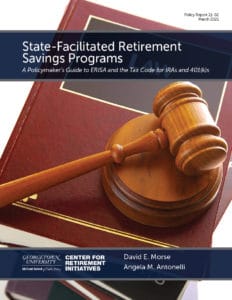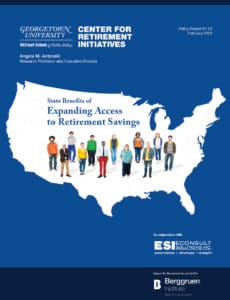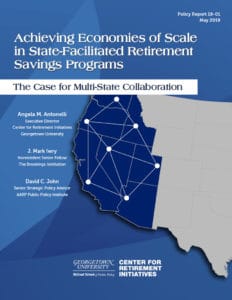State Reports and Briefs 2022

Policy Report 21-02 | March 2021
State-Facilitated Retirement Savings Programs: A Policymaker’s Guide to ERISA and the Tax Code for IRAs and 401(k)s
This paper provides policymakers with a primer about ERISA and the Tax Code, how these federal laws and their regulations pertain to IRAs and 401(k)s, and what this means for state-facilitated retirement savings programs. After reviewing the question of ERISA applicability to state auto-IRAs and an overview of the federal Tax Code and IRA rules, it explores how ERISA and the Tax Code rules apply to 401(k)s, including the new rules allowing states (and others) to possibly lower 401(k) costs by sponsoring group 401(k)MEPs and PEPs.

Policy Report 19-01 | May 2019
State Benefits of Expanding Access to Retirement Savings
This report provides state-level analysis of the benefits of expanding worker access to save for retirement through state-facilitated auto-IRA programs. This report follows CRI’s earlier research on the potential benefits of national universal access to retirement savings options for U.S. workers (See Policy Report 20-02). Included in the analysis are 51 state (and DC) fact sheets that provides information on key state specific metrics including demographic trends related to the aging of the population, the size of the retirement savings access gap, the projected growth in savings with an auto-IRA program, and the economic and fiscal benefits to the state of adding new savers. (See State-by-State Interactive Map)

Policy Report 21-02 | March 2021
Achieving Economics of Scale in State-Facilitated Retirement Savings Programs: The Case for Multi-State Collaboration
This final report updates and replaces CRI Working Paper 18-02, published in June 2018. This report outlines several models, based on a multi-state or regional approach, that should be explored for how states can work together to serve more than one state. Although individual states can establish their own state-sponsored retirement savings programs, the consideration of interstate arrangements offers opportunities for states to explore how they can achieve economies of scale to help minimize costs while significantly expanding access to retirement savings options.
